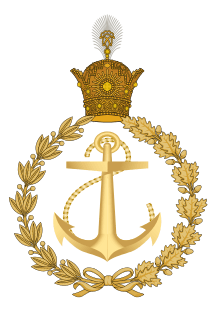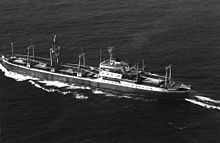History of the Iranian Navy
| Iranian Navy | |
|---|---|
| Leadership | |
| Rear Admiral | Habibollah Sayyari |
| Branches and manpower | |
| Navy | 13,400 |
| Marines | 2,600 |
| Aviation | 2,000 |
| History | |
| History of the Iranian Navy | |
| Personnel | |
| List of Iranian Navy senior officers | |
| Iran's Navy Ranks Insignia | |
| Equipment | |
| Historical Vessels | |
| Current Vessels | |



.jpg)
The Iranian Navy, traditionally located in the shallow waters of the Persian Gulf, has always been the smallest of the country's military forces. An Iranian navy in one form or another has existed since Achaemenid times in 500 BC; however, except for the Achaemanid navy, none of the following navies were particularly well organised or strong. It was only with the Pahlavi dynasty in the 20th century that Iran began to consider building a strong navy to project its strength into the Arabian Sea and Indian Ocean. In more recent years, the country has engaged in domestic ship building industries in response to the western-backed first Gulf War (also known as the Iran-Iraq war), which left it without suppliers during an invasion.
Pahlavi era
The Imperial Iranian Navy (IIN) was the name of Iran's navy, until the Iranian Revolution in 1979.
It was nearly destroyed during a surprise attack by Britain and the Soviet Union in World War II, which began the Anglo-Soviet invasion of Iran. Numerous Iranian ships were sunk or damaged while still moored at their home ports.
Following World War II, the fleet began replacing destroyed warships with destroyers, frigates and many smaller vessels, including powerboats and hovercraft, many of which originated from the U.S. and UK, which had played a part in destroying much of the original equipment in World War II. In the 1970s, Iran planned to extend its naval reach into the Indian Ocean; but this goal was curtailed by the revolution, and the ensuing western-backed first Gulf War (Iran–Iraq War) (1980–1988) which left it hampered in the face of the invasion.
The Imperial Iranian Navy regained control of the Tunb and Abu Musa islands on the 30th of November 1971, following the British withdrawal from these islands.
Since before 1971, the navy had been supplied primarily with American and British equipment. Up until 1979, Iran rapidly modernised its navy, adding American and British-made destroyers, frigates and many smaller vessels, including hovercraft. Aircraft were also included.
During this period, Iran established an aviation capability in its navy. It was mainly equipped with American aircraft types.
Iran also had orders for more American and British naval armaments by the time of the Iranian revolution.
An Ol class tanker was ordered from the United Kingdom. Called Kharg, this was built in 1977 but, not delivered until 1984.
Four Kidd class destroyers, were ordered from the USA, while eight modified Kortenaer class frigates were ordered from Royal Schelde in the Netherlands. The revolution happened before any of the ships could be delivered, so, both orders were cancelled. The Kidd class destroyers then went into service with the United States Navy and later, with the Republic of China (Taiwan) Navy, where they are still in service.
Islamic Republic of Iran
With the fall of the Shah in the revolution of 1979, the Imperial Iranian Navy was renamed as the Islamic Republic of Iran Navy. From then on, the United States began economic sanctions, severely hampering Iran's ability to maintain and equip its Navy. In fact, the Navy was more severely affected than the Army or Air Force. Several of Iran's ships had to be laid up.
Iran Iraq War
The Iran-Iraq War lasted from 1980 to 1988. The IRI Navy played a role in it. During this time, battles fought with Iraq and the United States, also degraded Iran's conventional naval assets.
One such battle was Operation Morvarid, involving the Islamic Republic of Iran Navy.
Post Iran Iraq War
In place of western equipment, Iran has purchased equipment from Russia, China, and North Korea, as well as engaging in naval exercises with Pakistan and India. The 1990s saw Iran focusing on building up its fleets of patrol boats and submarines, as well as surface-to-surface, anti-ship missiles.
Iran's goal has always been to provide escort for Iranian shipping in the Persian Gulf, as well as being able to disrupt enemy shipping, as was witnessed in the Iran–Iraq War.
On 22 February 2011, two Islamic Republic of Iran Navy ships entered the Suez Canal, on a deployment reported to be a training mission to Latakia, Syria. These were the tanker Kharg, and the frigate Alvand. This was the first time that Iranian naval ships had passed through the Suez Canal, since the 1979 Iranian revolution.
On 18 February 2012, the Kharg entered the Suez Canal again, with one other Iranian warship, after briefly docking at Jeddah in Saudi Arabia.
See also
- Operation Morvarid
- Operation Praying Mantis The 1988 American attack on the Iranian Navy.
- Islamic Republic of Iran Navy
References
External links
| ||||||||||||||||||||||||||||||||||||||||||
